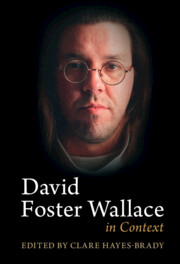Book contents
- David Foster Wallace in Context
- David Foster Wallace in Context
- Copyright page
- Contents
- Figures
- Contributors
- Acknowledgments
- Abbreviations
- Introduction
- Part I Contexts
- Chapter 1 David Foster Wallace and Narratology
- Chapter 2 A Meeting of Minds
- Chapter 3 Writing in a Material World
- Chapter 4 Confidence Man
- Chapter 5 David Foster Wallace and European Literature
- Chapter 6 David Foster Wallace and Poetry
- Chapter 7 David Foster Wallace’s “Non”-Fiction
- Chapter 8 “Thanks Everybody and I Hope You Like It”
- Chapter 9 David Foster Wallace and Visual Culture
- Part II Ideas
- Part III Bodies
- Part IV Systems
- Works by David Foster Wallace
- Bibliography of Secondary Sources
- Index
Chapter 9 - David Foster Wallace and Visual Culture
from Part I - Contexts
Published online by Cambridge University Press: 18 November 2022
- David Foster Wallace in Context
- David Foster Wallace in Context
- Copyright page
- Contents
- Figures
- Contributors
- Acknowledgments
- Abbreviations
- Introduction
- Part I Contexts
- Chapter 1 David Foster Wallace and Narratology
- Chapter 2 A Meeting of Minds
- Chapter 3 Writing in a Material World
- Chapter 4 Confidence Man
- Chapter 5 David Foster Wallace and European Literature
- Chapter 6 David Foster Wallace and Poetry
- Chapter 7 David Foster Wallace’s “Non”-Fiction
- Chapter 8 “Thanks Everybody and I Hope You Like It”
- Chapter 9 David Foster Wallace and Visual Culture
- Part II Ideas
- Part III Bodies
- Part IV Systems
- Works by David Foster Wallace
- Bibliography of Secondary Sources
- Index
Summary
This chapter examines the relationship between Wallace’s writing and works of visual art. Beginning with the many moments of ekphrasis that punctuate the writing, ranging from myths of tapestry-weaving to Leutze’s mural of Manifest Destiny, encompassing Bernini and Escher in Infinite Jest alone, this chapter explores the ways in which Wallace makes use of the language of images in his writing, situating narrative in conversation with visual culture and reaching beyond language to image, color and texture. Reflecting on prior scholarly attention to art positioned in Wallace’s writing, the chapter explores the connections between attention and aesthetic. The chapter also examines the ways in which visual cues appear in other ways in Wallace’s work, from the defecatory art of Brint Moltke in “The Suffering Channel” to the incidence of color as a motif throughout the work, specifically Wallace’s insistent references to clothing. The chapter highlights the materiality of these instances, attending to both the visual and the haptic elements of his narrative deployment of art in fictional worlds. This chapter works in concert with the next, delineating the intermediate nature of Wallace’s writing, poised between language, sense and image, and how his inclusion and occlusion of art recalibrate and reflect the relationships between author and reader.
Keywords
- Type
- Chapter
- Information
- David Foster Wallace in Context , pp. 96 - 106Publisher: Cambridge University PressPrint publication year: 2022

